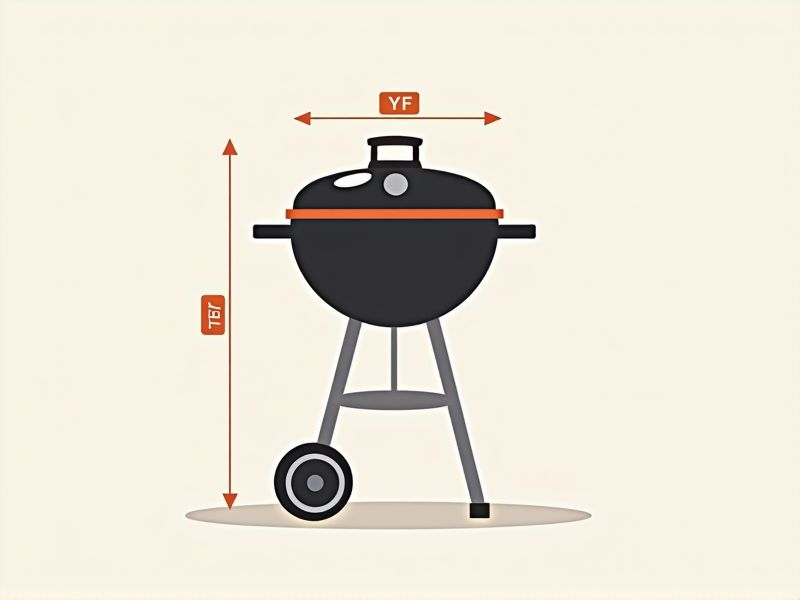
When choosing a BBQ grill, understanding standard dimensions helps ensure a good fit for your space and cooking needs. Most freestanding gas or charcoal grills have a width between 24 and 36 inches, a depth of 16 to 24 inches, and a height around 40 to 48 inches with the lid closed. For a typical family, a grill with about 400-500 square inches of cooking area is sufficient, allowing you to cook 20-24 burgers at once. Measuring your available outdoor space before purchasing will help you select the right size and avoid any installation issues.
Cooking Surface Area
When selecting a BBQ grill, the cooking surface area is crucial for accommodating your cooking needs. A standard grill typically offers 400 to 800 square inches of cooking space, which is ideal for backyard gatherings or family barbecues. If you're hosting large parties, consider models with over 800 square inches to ensure you can cook multiple items simultaneously. Remember, a larger cooking surface not only increases efficiency but also enhances the overall grilling experience by allowing you to manage heat zones effectively.
Grill Height
The ideal grill height for BBQ grills typically ranges between 30 to 36 inches, allowing for comfortable cooking without excessive bending. A height of 34 inches is often considered standard, providing an ergonomic setup for most users. When selecting a grill, ensure that the height accommodates your cooking style and allows for easy access to food. Your grilling experience can be significantly enhanced by choosing a height that minimizes strain while maximizing accessibility.
Grate Spacing
Grate spacing on BBQ grills typically ranges from 1 to 2 inches, which is crucial for achieving even cooking and preventing smaller food items from falling through. A spacing of 1.5 inches is often ideal, striking a balance between airflow and support for various foods. Grills with adjustable grates allow you to customize this spacing, enhancing versatility for grilling vegetables, meats, and seafood. Ensuring your grill has the right grate spacing can significantly influence your cooking experience and the quality of your BBQ meals.
Lid Clearance
When selecting a BBQ grill, a crucial aspect to evaluate is the lid clearance, typically ranging from 6 to 12 inches. This measurement significantly impacts cooking efficiency; a higher clearance allows for better heat circulation and prevents flare-ups. For optimal performance, choose a grill that matches your cooking style, whether it's smoking, roasting, or searing. Ensuring your grill's lid clearance meets these standards can enhance your outdoor cooking experience and deliver perfectly cooked meals.
Side Shelf Dimensions
When selecting a BBQ grill, the side shelf dimensions significantly affect your cooking experience. A standard side shelf typically measures between 24 to 32 inches in width and 10 to 15 inches in depth, providing ample space for food preparation and tool placement. This additional workspace is essential, as it allows you to organize your utensils, sauces, and ingredients conveniently, improving efficiency during grilling. Ensuring adequate side shelf dimensions can enhance both safety and comfort as you create your favorite barbecue dishes.
Base Footprint
The standard base footprint for BBQ grills typically ranges from 400 to 600 square inches, providing ample cooking space for various foods. Models designed for backyard use often feature a base width of 20 to 30 inches, ensuring stability while accommodating different outdoor terrains. Portable BBQ grills, ideal for camping or tailgating, often have a compact footprint of 200 to 300 square inches, making them easy to transport. When selecting your grill, consider the base design, as a sturdy and robust foundation not only affects performance but also enhances safety during cooking.
Grill Width
The standard BBQ grill width typically ranges from 22 to 36 inches, depending on the model and type. A wider grill allows for increased cooking space, accommodating larger cuts of meat and multiple items at once, which is ideal for gatherings. For optimal grilling performance, ensure that the grill design supports even heat distribution, as this enhances cooking efficiency. When selecting a grill, consider your outdoor space and cooking needs to choose an appropriate width that fits your grilling style.
Grill Depth
Grill depth significantly impacts cooking efficiency and heat distribution, with an ideal measurement ranging from 18 to 24 inches for even grilling. A deeper grill allows for better air circulation, promoting consistent temperatures across the cooking surface, which is crucial for perfectly cooked meats. For optimal results, consider grills with adjustable depth settings that accommodate various cooking styles, including direct and indirect grilling. Investing in a grill that meets these standards can enhance your BBQ experience by ensuring your meals are cooked evenly and to perfection.
Handle Length
Handle length is a crucial standard when evaluating BBQ grills, often ranging between 12 to 18 inches for optimal user comfort and safety. A longer handle enhances heat protection, allowing you to maneuver the grill without risking burns, especially during intense cooking sessions. Manufacturers design handles to accommodate various grill sizes, ensuring you can maintain control without leaning too close to the heat source. Choosing a grill with a well-designed, ergonomically positioned handle can significantly improve your grilling experience and safety.
Wheelbase Size
The wheelbase size of a BBQ grill plays a crucial role in its stability and maneuverability, impacting overall performance during cooking. Grills with larger wheelbases, typically measuring 35 inches or more, offer enhanced stability on various surfaces, minimizing the risk of tipping over. For backyard setups, a wheelbase of around 28 to 32 inches is often preferred for a good balance between portability and security. When selecting your BBQ grill, consider how the wheelbase aligns with your cooking habits and outdoor space to ensure a safe grilling experience.
